In industrial operations, reliable equipment forms the foundation of success. When machines run without unexpected stops, it boosts productivity and cuts operational costs.
This article explores four top methods to enhance your equipment’s reliability, ensuring smooth operations and long-term efficiency.
Best Practice #1: Regular Upkeep and Checks
Regular upkeep and checks form the backbone of keeping equipment reliable. When you plan routine check-ups, you can spot potential problems before they turn into big issues. This forward-thinking approach not only makes your machines last longer but also ensures they keep working well. A good maintenance schedule has both preventive and corrective parts. Preventive maintenance includes regular tasks like cleaning, lubricating, and making small adjustments to stop things from wearing out. Corrective maintenance fixes problems found during checks. Using both these methods keeps your equipment working great.
Best Practice #2: Predictive Maintenance Methods
Predictive maintenance goes beyond regular upkeep by using cutting-edge tech to forecast equipment breakdowns. This method depends on data analysis, sensors, and constant monitoring to check machine health and anticipate future issues. When you put predictive maintenance into action, you can cut down on surprise breakdowns and fix expenses. Tools like vibration checks, heat imaging, and oil tests give you a peek into how your machines are doing. These gadgets spot oddities and wear signs that you might miss during usual look-overs. What’s more, predictive maintenance lets you plan fixes during scheduled downtime, keeping your work flowing. This smart move not only makes your gear more reliable but also gets the most out of your upkeep resources, making sure you spend time and money where it counts the most.
Best Practice #3: Quality Equipment and Technology
Investing in high-quality equipment and technology is a crucial step towards bolstering reliability. Superior machinery is often more durable and requires less frequent maintenance, making it a cost-effective choice in the long run. When selecting equipment, consider factors such as durability, energy efficiency, and ease of maintenance. For example, steam systems and steam traps play a vital role in many industrial operations. Investing in high-quality steam traps can prevent steam leaks, which are not only wasteful but can also lead to operational inefficiencies. Additionally, advanced steam systems with automated controls can optimize energy use and improve overall system reliability. Moreover, staying updated with the latest technological advancements can provide a competitive edge.
Best Practice #4: Employee Training and Engagement
Training and engaging employees plays a key role in keeping equipment reliable. Staff with good training can spot potential problems and do basic upkeep, which makes equipment breakdowns less likely. When you invest in thorough training programs, you make sure your team has the skills and know-how to handle equipment the right way. Training and engagement work together. When you promote a culture where employees feel responsible and alert, they take a more active role in managing equipment. Engaged workers are more likely to speak up about problems and offer ideas for making things better.
Wrap Up
To boost how well equipment works in industrial settings, you need to do several things. These include doing regular upkeep and checks using methods to predict when maintenance is needed, buying high-quality gear, and helping employees learn and stay involved. By doing all this, you can improve how tough and efficient your operations are.






